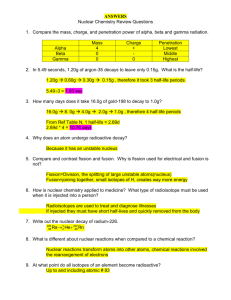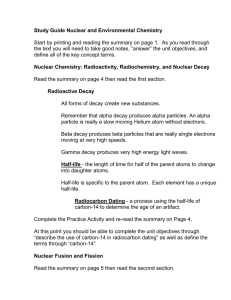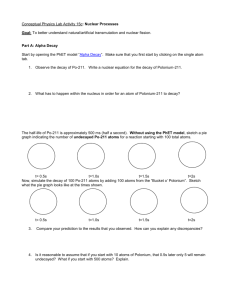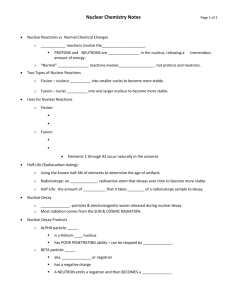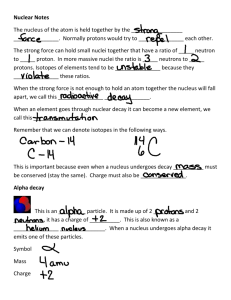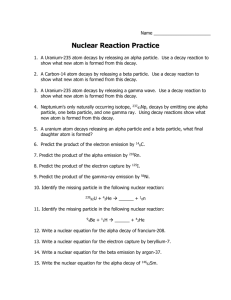PhET Radioactive Decay Lab
advertisement
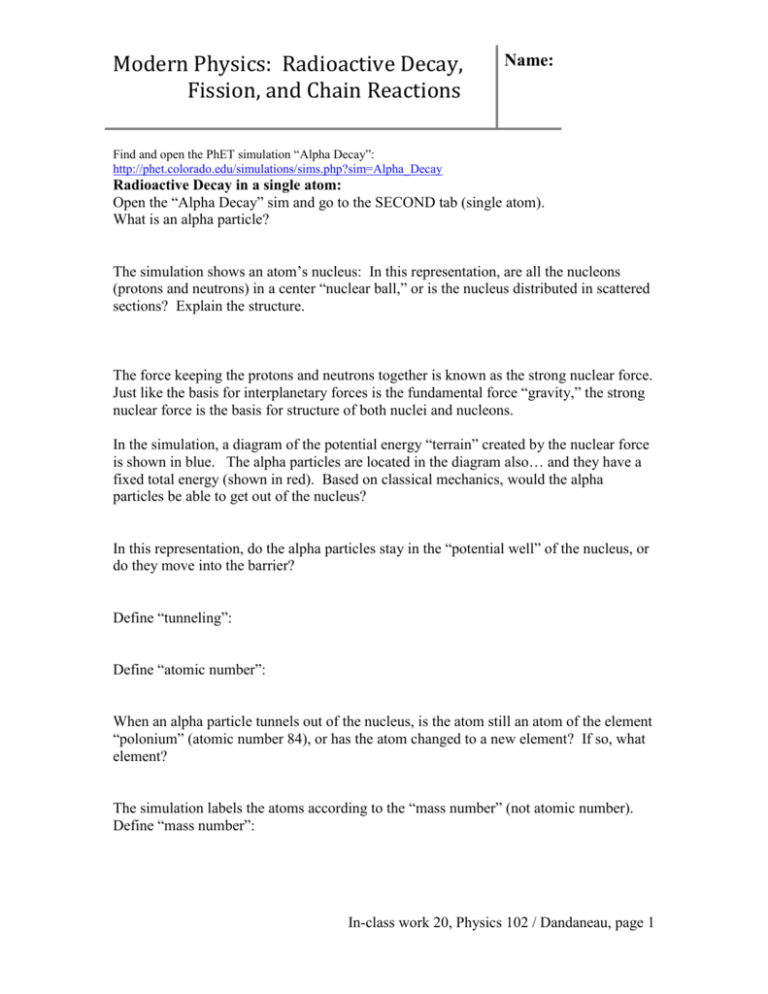
Modern Physics: Radioactive Decay, Fission, and Chain Reactions Name: Find and open the PhET simulation “Alpha Decay”: http://phet.colorado.edu/simulations/sims.php?sim=Alpha_Decay Radioactive Decay in a single atom: Open the “Alpha Decay” sim and go to the SECOND tab (single atom). What is an alpha particle? The simulation shows an atom’s nucleus: In this representation, are all the nucleons (protons and neutrons) in a center “nuclear ball,” or is the nucleus distributed in scattered sections? Explain the structure. The force keeping the protons and neutrons together is known as the strong nuclear force. Just like the basis for interplanetary forces is the fundamental force “gravity,” the strong nuclear force is the basis for structure of both nuclei and nucleons. In the simulation, a diagram of the potential energy “terrain” created by the nuclear force is shown in blue. The alpha particles are located in the diagram also… and they have a fixed total energy (shown in red). Based on classical mechanics, would the alpha particles be able to get out of the nucleus? In this representation, do the alpha particles stay in the “potential well” of the nucleus, or do they move into the barrier? Define “tunneling”: Define “atomic number”: When an alpha particle tunnels out of the nucleus, is the atom still an atom of the element “polonium” (atomic number 84), or has the atom changed to a new element? If so, what element? The simulation labels the atoms according to the “mass number” (not atomic number). Define “mass number”: In-class work 20, Physics 102 / Dandaneau, page 1 How many protons are in the original atom (polonium-211)? How many neutrons? How many protons are in the atom after it decays to lead-207? How many neutrons? What is the difference in protons and neutrons, and what nuclei/particle does that comprise? The simulation has a reset button. When you reset it (many times to check well), is the time is takes the new nucleus to decay (about) the same as the old time or is it random? Radioactive Decay in a sample of atoms: While the atomic decay is random, for larger amounts of radioactive material, the overall decay of the population of atoms can be characterized by a constant known as the “halflife” (the time is takes for about half of the amount to decay). Now go to the FIRST tab (multiple atoms) and keep adding 10 atoms until the entire bucket is empty (there are 99 total atoms). Because the simulation starts automatically, you’ll need to “Reset all Nuclei” before you take data. Every ½ second, pause the simulation and note the number of polonium atoms. Plot below: Number of Polonium atoms remaining 100 75 50 25 0 1 2 3 Time elasped (seconds) What is the mathematical shape of the graph (linear, parabolic, etc.)? In-class work 20, Physics 102 / Dandaneau, page 2 Practice: Say material “X” decays radioactively into material “Y” with a characteristic half life of two days. Assume you start with 100 kg of X. In the graph below, plot the amount of material of “X” that remains after 2 days, 4 days, 6 days, and 10 days: Mass of X remaining (kg) 100 75 50 25 0 5 10 Time elasped since X first measured at 100 kg (days) Say X has a safe level of 5 kg (for the given area it is located in). How long does it take to reach a safe level? If the original level is 50 kgs (half the original size), does it take half the time to reach a safe level? Explain. (You may want to add a plot of this sample to your graph to help you, though it isn’t required.) Add a plot for the decay of 100 kg of material “Z,” which has a half-life of 1 day. Label this line. Then answer this question: how long does it take material z to reach a safe level of 5 kg? How does this compare to the time it took material X to decay to this level? What happens to the mass lost by X in the radioactive decay? Is mass conserved, and if so, how? In-class work 20, Physics 102 / Dandaneau, page 3 Fission: Open the “Nuclear Fission” sim: http://phet.colorado.edu/simulations/sims.php?sim=Nuclear_Fission Start at the tab “Fission: One Nucleus” Define fission: Run the simulation. Before the gun is fired, is the material stable, or does it seem likely to radioactively decay? When you operate the gun, what type of particle does it fire? If the gun fires and “hits” the nucleus, what happens? Switch the tab to “chain reaction” and add some uranium-238. The atom used in the previous tab was uranium-235. Is uranium-238 “fissionable”? How does firing the gun on a uranium-238 atom change it? (Note you can aim the gun.) Chain reaction: Switch to the tab “Chain Reaction”. Reset the sim (using the button) and add lots of fissionable uranium-235. What happens and why? Normal levels of the uranium-235 isotope are about 0.72%, with the majority being uranium-238. Round the level up to 1% (in the favor of uranium-238), to one atom of uranium-235 and 99 atoms of uranium 238. Use the simulation to discover if naturallyderived uranium can start a chain reaction (and therefore be useful in either nuclear weapons or nuclear power plants): Is naturally derived uranium able to start a chain reaction, or must the sample be “enriched”? Use the simulation to find a minimum ratio of uranium-235 to uranium-238 (keep your total of atoms always at 100); what is the smallest percentage that still starts a chain reaction? In-class work 20, Physics 102 / Dandaneau, page 4 How does the above compare to “weapons-grade” enriched uranium (about 80-85%)? Use the simulation to make a nuclear weapon. What conditions are needed? (Hint, you’ll need a containment vessel, and a certain level of enrichment that you must determine.) What is a “dirty-bomb” (you may have to look it up online). Is a high grade of uranium needed for a dirty-bomb to explode? Nuclear power plants: Switch to the “Nuclear Reactor” tab. What is needed to start the nuclear reactor? What does adjusting the control rods do? Without the control rods in position, what happens? Homer Simpson is asleep at the Springfield Nuclear Power Plant (where he’s known to occasionally work.. although mostly he’s asleep at the controls). When the power plant sounds an alarm (d’oh!), what is happening, and what must Homer do to save the day? http://www.yoest.org/archives/homer_simpson_nnuclear_power_plant.jpg In-class work 20, Physics 102 / Dandaneau, page 5

